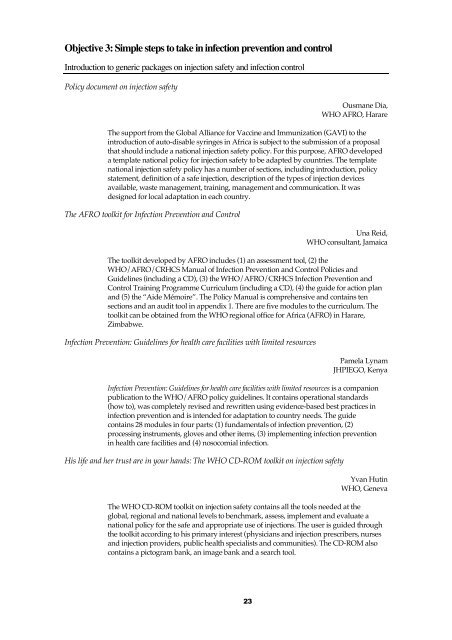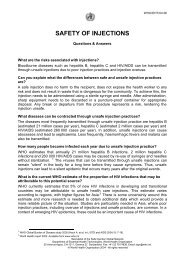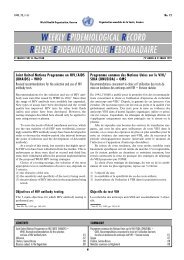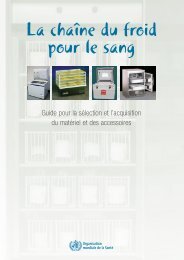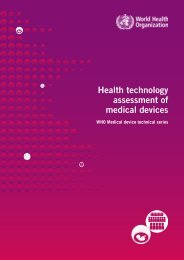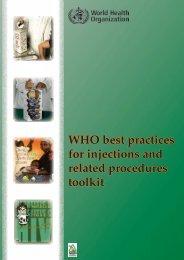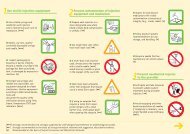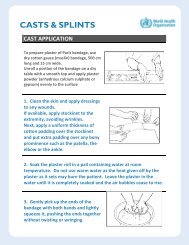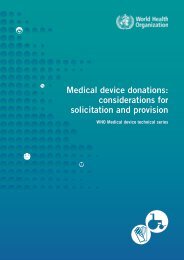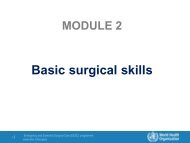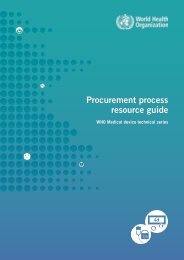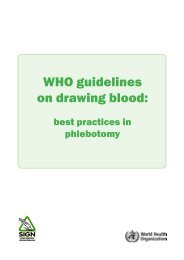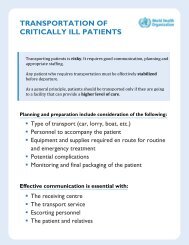SIGN meeting report 2003. - World Health Organization
SIGN meeting report 2003. - World Health Organization
SIGN meeting report 2003. - World Health Organization
Create successful ePaper yourself
Turn your PDF publications into a flip-book with our unique Google optimized e-Paper software.
Objective 3: Simple steps to take in infection prevention and control<br />
Introduction to generic packages on injection safety and infection control<br />
Policy document on injection safety<br />
Ousmane Dia,<br />
WHO AFRO, Harare<br />
The support from the Global Alliance for Vaccine and Immunization (GAVI) to the<br />
introduction of auto-disable syringes in Africa is subject to the submission of a proposal<br />
that should include a national injection safety policy. For this purpose, AFRO developed<br />
a template national policy for injection safety to be adapted by countries. The template<br />
national injection safety policy has a number of sections, including introduction, policy<br />
statement, definition of a safe injection, description of the types of injection devices<br />
available, waste management, training, management and communication. It was<br />
designed for local adaptation in each country.<br />
The AFRO toolkit for Infection Prevention and Control<br />
Una Reid,<br />
WHO consultant, Jamaica<br />
The toolkit developed by AFRO includes (1) an assessment tool, (2) the<br />
WHO/AFRO/CRHCS Manual of Infection Prevention and Control Policies and<br />
Guidelines (including a CD), (3) the WHO/AFRO/CRHCS Infection Prevention and<br />
Control Training Programme Curriculum (including a CD), (4) the guide for action plan<br />
and (5) the “Aide Mémoire”. The Policy Manual is comprehensive and contains ten<br />
sections and an audit tool in appendix 1. There are five modules to the curriculum. The<br />
toolkit can be obtained from the WHO regional office for Africa (AFRO) in Harare,<br />
Zimbabwe.<br />
Infection Prevention: Guidelines for health care facilities with limited resources<br />
Pamela Lynam<br />
JHPIEGO, Kenya<br />
Infection Prevention: Guidelines for health care facilities with limited resources is a companion<br />
publication to the WHO/AFRO policy guidelines. It contains operational standards<br />
(how to), was completely revised and rewritten using evidence-based best practices in<br />
infection prevention and is intended for adaptation to country needs. The guide<br />
contains 28 modules in four parts: (1) fundamentals of infection prevention, (2)<br />
processing instruments, gloves and other items, (3) implementing infection prevention<br />
in health care facilities and (4) nosocomial infection.<br />
His life and her trust are in your hands: The WHO CD-ROM toolkit on injection safety<br />
Yvan Hutin<br />
WHO, Geneva<br />
The WHO CD-ROM toolkit on injection safety contains all the tools needed at the<br />
global, regional and national levels to benchmark, assess, implement and evaluate a<br />
national policy for the safe and appropriate use of injections. The user is guided through<br />
the toolkit according to his primary interest (physicians and injection prescribers, nurses<br />
and injection providers, public health specialists and communities). The CD-ROM also<br />
contains a pictogram bank, an image bank and a search tool.<br />
23


